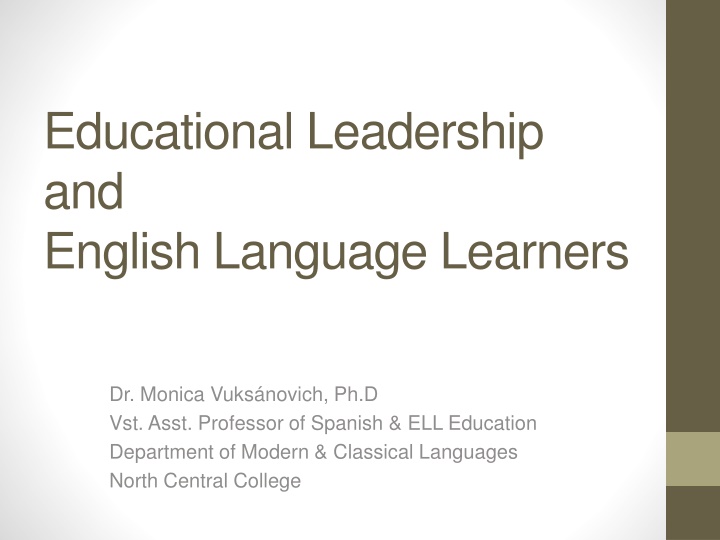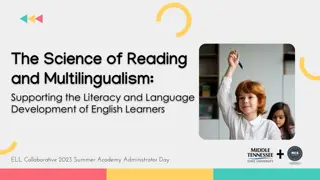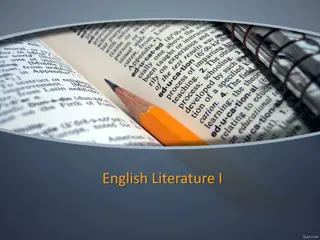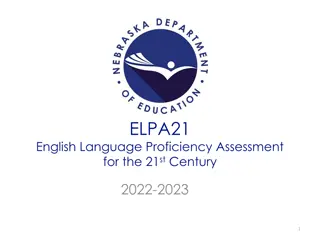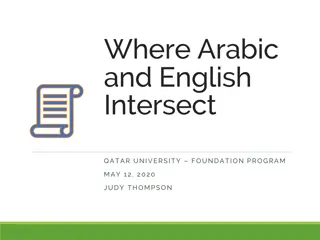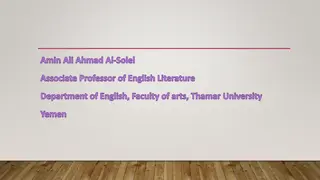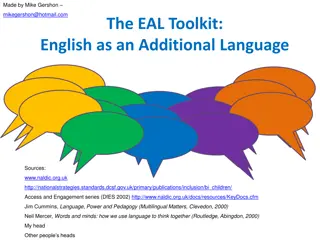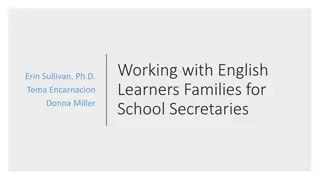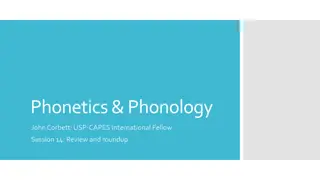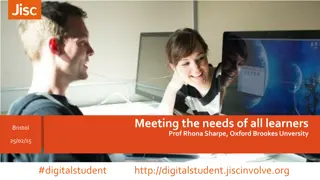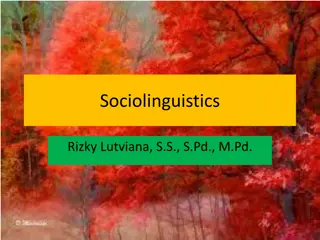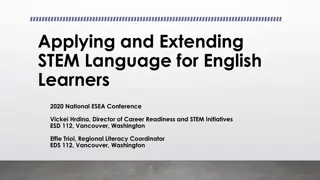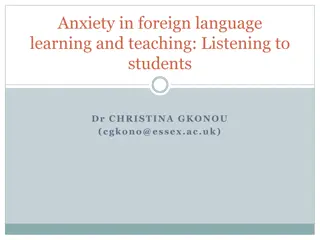English Language Learners: Key Aspects
Who ELLs are, the laws governing their education, optimal learning methods, and the concept of proficiency, including relevant data on ELLs in Illinois and educational legislation.
Download Presentation

Please find below an Image/Link to download the presentation.
The content on the website is provided AS IS for your information and personal use only. It may not be sold, licensed, or shared on other websites without obtaining consent from the author.If you encounter any issues during the download, it is possible that the publisher has removed the file from their server.
You are allowed to download the files provided on this website for personal or commercial use, subject to the condition that they are used lawfully. All files are the property of their respective owners.
The content on the website is provided AS IS for your information and personal use only. It may not be sold, licensed, or shared on other websites without obtaining consent from the author.
E N D
Presentation Transcript
Educational Leadership and English Language Learners Dr. Monica Vuks novich, Ph.D Vst. Asst. Professor of Spanish & ELL Education Department of Modern & Classical Languages North Central College
What do we need to know? Who are ELLs? What is the law? How do ELLs learn best? What should a principal know?
Who are ELLs? In Illinois (2010): 183,522 ELLs in 579 districts Linguistically and culturally diverse While about 80% are Spanish speakers, 141 different home languages were represented in Illinois in 2010
What is the law? Equal Educational Opportunities Act (EEOA), Section 1703(f) a school district must provide services that will enable LEP students to overcome barriers that impede equal participation by these students in the district s instructional programs (see 20 USC 1703) Elementary and Secondary Education Act (ESEA/NCLB) Title III - 'English Language Acquisition, Language Enhancement, and Academic Achievement Act'. Sec. 3102 (1) to help ensure that children who are limited English proficient, including immigrant children and youth, attain English proficiency, develop high levels of academic attainment in English, and meet the same challenging State academic content and student academic achievement standards as all children are expected to meet Illinois School Code Article 14C Transitional Bilingual Education 105 ILCS 5/14C-1 to insure equal educational opportunity to every child, and in recognition of the educational needs of children of limited English-speaking ability, it is the purpose of this Act to provide for the establishment of transitional bilingual education programs in the public schools, to provide supplemental financial assistance to help local school districts meet the extra costs of such programs, and to allow this State to directly or indirectly provide technical assistance and professional development to support transitional bilingual education programs statewide. Illinois Administrative Code Title 23 Part 228 Transitional Bilingual Education Identification of Eligible Students; Data Collection; Program Options & Placement; Assessment; Personnel Qualifications and Professional Development; Program Evaluation Hernandez, R. (2011)
How do ELLs learn best? Communicative Language Teaching and Task-based instruction [1980 s - present day] from a highly qualified teacher with ELL/Bilingual Certification/Endorsement CLT is an approach, not a method (SIOP and CALLA are two popular commerical methods)
What is proficiency? BICS CALP Cummins (1991)
How long will it take? ELL Students Native Speakers 5-7 (up to 10 ) years 2 years Social English Academic English Based on Cummins (1991), Collier (1995)
When is a student considered proficient ? Overall composite proficiency level of 4.8 as well as a 4.2 composite literacy (reading/writing) proficiency level on ACCESS for ELLs are considered English Language Proficient and can exit ELL programming. 6 5 4 R E A C H I N G BRIDGING 3 2 EXPANDING 1 DEVELOPING BEGINNING ENTERING
How are ELLs assessed? Step 1: Home language survey Step 2: Placement tests for ELLs Preschool: Pre-IPT Oral (listening & speaking) K-1: Measure of Developing English Language (MODEL) 1-12: WIDA Access Placement Test (W-APT) for new students Step 3: Proficiency tests ELLs annually take the ACCESS for ELLs test to assess ELP and linguisticially modified ISAT/PSAEs to assess academic growth
What are the programs in IL? TBE (Transitional Bilingual Education) >20 LEP of same L1. What does TBE look like? Bilingual teacher instructs math, science, and social studies in student s L1. Lang Arts is bilingual (scaffolded English with emphasis on L1 literacy at first) and PE & Art are in English. TPI (Transitional Program of Instruction) <20 LEP of same L1. What does TPI look like? P-6 = Pull out or push in program 7-12 = 1-2 ELL classes per day, plus sheltered math and science. These classes parallel the regular curriculum but are taught in a modified manner.
What should a principal know? Broad Administrative Knowledge of ELLs New Initiatives and State/Fed Mandates Family / Community Engagement Professional Development ELL Specialized Knowledge Classroom Management Incl Gifted & Magnet ELL Ed Policy Assessment Curriculum Instruction Education, Specialist Services Special Adapted from Hernandez, Reyna (2011)
What are key questions for Ed Leadership and ELLs? 1. How should my school/district provide appropriate and differentiated instructional services to all ELLs? 2. What programs models support ELLs? 3. What does fair assessment for ELLs look like? 4. How does an instructional leader analyze and evaluate the English Language Learning classroom, and how does that leader know what effective instructor practices and student behaviors to look for? 5. What strategies should an instructional leader promote to create collaborative learning teams among teachers? 6. What are the central features of action plans for English Language Learning excellence? Adapted from the National Institute for School Leadership (2011)
Next steps? Move to Dr. Joe Pacha s draft of the ELL Assessment Rubric
Resources Highly Recommended Texts Alford, B. and Mary C. Nino (2011). Leading Academic Achievement for English Language Learners: A Guide for Principals. Corwin. ISBN-10: 1412981603 ISBN-13: 978-1412981606 Smiley, P. and Trudy Salisbury. (2007). Effective Schooling for English Language Learners: What Elementary Principals Should Know and Do. Eye on Education. ISBN-10: 1596670304 ISBN-13: 978-1596670303 Suggested Additional Texts Houk, Farin. (2005). Supporting English Language Learners: A Guide for Teachers and Administrators. Heinenman. ISBN-10: 0325006997 ISBN-13: 978-0325006994 Prek-12 English Language Proficiency Standards. (2006). TESOL. ISBN-10: 93118531X ISBN-13: 978-1931185318 Lindsey, R., Nuri-Robbins, K., and Raymond Terrell. (2009). Cultural Proficiency: A Manual for School Leaders. Corwin Press. ISBN-10: 141296363X ISBN-13: 978-1412963633 Theoharis, G. (2009). The School Leaders Our Children Deserve: Seven Keys to Equity, Social Justice, and School Reform. Teachers College Press. ISBN-10: 0807749516 ISBN-13: 978-0807749517 Additional Supporting Texts Brock, Cynthia and Diane Lapp, Rachel Salas, and Dianna Townsend. ( 2009). Academic literacy for English learners : high-quality instruction across content areas. Teachers College Press: New York. Cloud, N., Genesee, F., Hamayan,E. (2009). Literacy Instruction for English Language Learners. Portsmouth, NH: Heinemann. Cruz , B rbara C. and Stephen J. Thornton. (2009). Teaching social studies to English language learners. Routledge: New York. Cummins, Jim, Kristin Brown, Dennis Sayers. (2007). Literacy, Technology and Diversity: Teaching for Success in Changing Times. Freeman, David E. and Yvonne S., (2000). Teaching Reading in Multilingual Classrooms. Portsmouth, NH: Heinemann. Freeman, David E. and Yvonne S. Freeman. (2001) Between Worlds: Access to Second Language Acquisition. Haynes, Judie. (2007). Getting started with English language learners : how educators can meet the challenge. ASCD: Alexandria, VA. Herrell, Adrienne and Michael Jordan. (2008). Fifty strategies for teaching English language learners. Pearson: New Jersey. Herrera, S.G., Perez,D.R., and Escamilla, K. (2010). Teaching Reading to English Language Learners: Differentiated Literacies. Boston, MA: Allyn & Bacon. Li, Guofang and Patricia A. Edwards, Eds. (2010). Best practices in ELL instruction. The Guilford Press: New York. Lightbown, Patsy M. Nina Spada. How Languages are Learned. Third Revised Edition. Patton O. (2008) One Child, Two Languages: A Guide for Early Childhood Educators of Children Learning English as a Second Language. Second edition. Tabors. Shatz, Marilyn and Louise C. Wilkinson, Eds. Education of English language learners : research to practice. The Guilford Press: New York. Whelan Ariza, Eileen N. Not for ESOL Teachers: What Every Classroom Teacher Needs to Know About the Linguistically, Culturally, and Ethnically Diverse Student Second Edition.
Resources TESOL (http://tesol.org/s_tesol/index.asp) : Teachers of English to Speakers of Other Languages (TESOL) is the primary professional development organization in the field of English language acquisition. ACTFL (http://actfl.org/i4a/pages/index.cfm?pageid=1): American Council on the Teaching of Foreign Languages is the primary professional development organization in the field of foreign language acquisition. ACTFL also address the teaching and learning of English as a Second Language.
References Hernandez, Reyna (2011). Powerpoint Presentation entitled Educational Administration and ELLs. LINC Conference. Cummins, J. (1991) Language Development and Academic Learning Cummins, J in Malave, L. and Duquette, G. Language, Culture and Cognition Clevedon: Multilingual Matters Collier, V.P. (1995). Acquiring a second language for school. Washington, DC: National Clearinghouse for Bilingual Education. National Institute for School Leadership. (2011) www.nisl.net/institutes/elli/content.php WIDA (2011). Steps to English Language Development. http://www.wida.us/standards/elp.aspx
